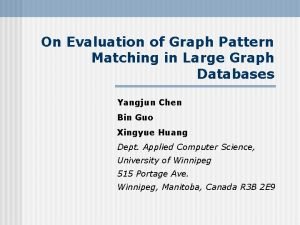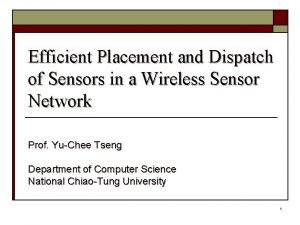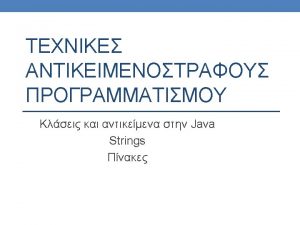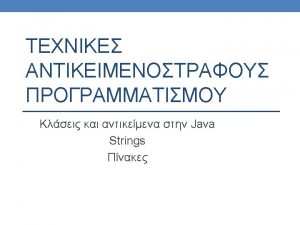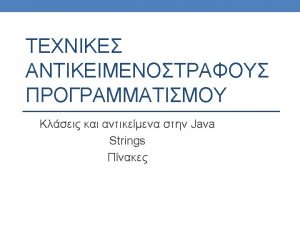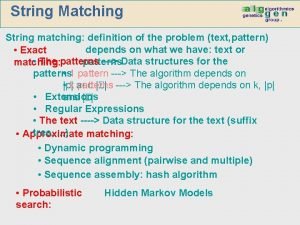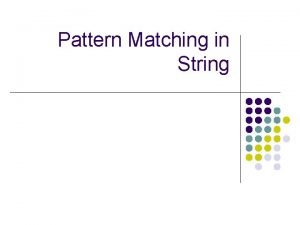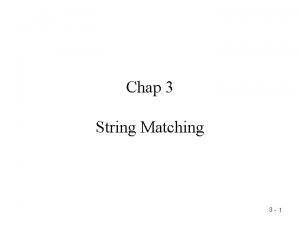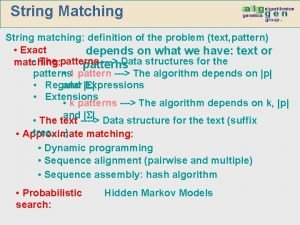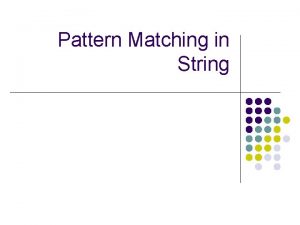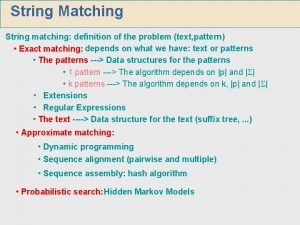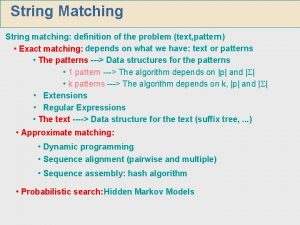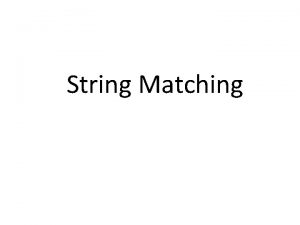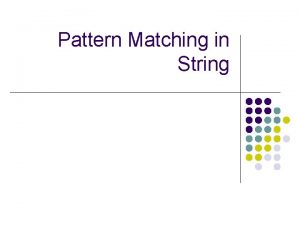Skip Search algorithm Very Fast String Matching Algorithm




























![References [BM 77] A Fast String Searching Algorithm , Boyer, R. S. and Moore, References [BM 77] A Fast String Searching Algorithm , Boyer, R. S. and Moore,](https://slidetodoc.com/presentation_image_h/f6f597af5db62ac3ad6b9b1c0b4846d8/image-29.jpg)
- Slides: 29

Skip Search algorithm Very Fast String Matching Algorithm for Small Alphabets and Long Patterns, Christian, C. , Thierry, L. and Joseph, D. P. , Lecture Notes in Computer Science, Vol. 1448, 1998, pp. 55 -64 Advisor: Prof. R. C. T. Lee Speaker: Z. H. Pan 1

Pattern length=m critical m m-1 x window Every matching of P with T will examine x. 2

Preprocessing • The Preprocessing phase of the Skip Search algorithm preprocesses the pattern by computing the buckets for all characters of the alphabet. Example: Text string T=GCATCGCAGAGAGTATACAGTACG 0 12 3 4 5 6 7 Pattern string P=GCAGAGAG A C G T (6, 4, 2) (1) (7, 5, 3, 0) φ the buckets for all characters of the alphabet 3

Search phase • The search phase checks what is the km-th symbol in the text string, where 1≦k ≦n/m. According the symbol to align every identical symbol in the pattern and executes matching. Note that the bucket record every symbols’ location in the pattern. Example: Text string T=aabcdbdabcabc Pattern string P=abcabc, m=6 critical T=aabcdbdabcabc The 6 -th symbol in T is b. Then we align it by the 5 -th symbol and executes matching. Then we align it by the 2 -th symbol and executes matching. abcabc 4

Full Example • Text string T=GCATCGCAGAGAGTATACAGTACG 0 12 34 5 6 7 • Pattern string P=GCAGAGAG A C G T (6, 4, 2) (1) (7, 5, 3, 0) Φ the buckets for all characters of the alphabet 5

critical 0 1 2 3 4 5 6 7 8 9 1011 12 131415161718 19 20 212223 GCATCGCAGAGAGTATACAGTACG GCAGAGAG mismatch GCAGAGAG exact match A C G T (6, 4, 2) (1) (7, 5, 3, 0) φ Then we check T[15]=T. Since there is no “T” in the pattern, we check T[23]=G. Then we shift pattern to align T[16… 23]. GCAGAGAG 6

Time Complexity • The space and time complexity of the preprocessing phase is O(m+σ)(σ is the number of alphabet. ) • The Skip Search algorithm has a quadratic worst case time complexity but the expected number of text character inspections is O(n). 7

KMP Skip Search Algorithm Very Fast String Matching Algorithm for Small Alphabets and Long Patterns, Christian, C. , Thierry, L. and Joseph, D. P. , Lecture Notes in Computer Science, Vol. 1448, 1998, pp. 55 -64 8

• The KMP Skip Search algorithm considers both Skip Search and KMP Search. It executes even is better. 9

Example: First it uses the Skip Search algorithm to align T and P. 0 1 2 3 4 5 6 7 8 9 10 11 12 13 14 15 16 17 18 19 20 21 22 23 24 25 26 27 28 29 30 31 32 33 34 35 T = ACTACATATAGGACTACGTACCAGCATTACTACGTT P = ACTACGT 0 1 2 3 4 5 6 ACTACGT (kmp’s shift) (skip’s shift) 0 1 2 3 4 5 6 7 8 9 10 11 12 13 14 15 16 17 18 19 20 21 22 23 24 25 26 27 28 29 30 31 32 33 34 35 T = ACTACATATAGGACTACGTACCAGCATTACTACGTT 0 1 2 3 4 5 6 ACTACGT 10

Example: 0 1 2 3 4 5 6 7 8 9 10 11 12 13 14 15 16 17 18 19 20 21 22 23 24 25 26 27 28 29 30 31 32 33 34 35 T = ACTACATATAGGACTACGTACCAGCATTACTACGTT 0 1 2 3 4 5 6 ACTACGT (kmp’s shift) (skip’s shift) 0 1 2 3 4 5 6 7 8 9 10 11 12 13 14 15 16 17 18 19 20 21 22 23 24 25 26 27 28 29 30 31 32 33 34 35 T = ACTACATATAGGACTACGTACCAGCATTACTACGTT 0 1 2 3 4 5 6 ACTACGT 11

Time Complexity • The preprocessing phase of kmp Skip Search is O(m+σ)(σ is the number of alphabet. ) • The Searching Phase of Kmp Skip Search algorithm is O(n). 12

Alpha skip Search Algorithm Very Fast String Matching Algorithm for Small Alphabets and Long Patterns, Christian, C. , Thierry, L. and Joseph, D. P. , Lecture Notes in Computer Science, Vol. 1448, 1998, pp. 55 -64 13

• The Alpha Skip Search Algorithm is an improvement of the Skip Search Algorithm. • The Skip Search Algorithm uses Rule 2, the substring matching rule and Rule 4, two window rule. 14

Rule 2: The Substring Matching Rule • For any substring u in T, find a nearest u in P which is to the left of it. If such an u in P exists, move P such then the two u’s match; otherwise, we may define a new partial window. 15

Rule 2 -2: 1 -Suffix Rule (A Special Version of Rule 2) • Consider the 1 -suffix x. We may apply Rule 2 -2 now. 16

Rule 4: Two Window Rule T= C G C A C G G T A C C T T A C G G T P= C T T A w 1 w 2 C G C A C G G T No prefix of P = a suffix of W 1. No suffix of P = a prefix of W 2. w 3 w 4 A C C T T A C G C T T A Matched! 17

We assume that the size of the alphabet Σ of the text and pattern is σ. In the preprocessing phase, we first use a formula to determine L and then find all substrings in pattern P whose length is L. The information about where the substrings are location in P is stored in a trie. In the searching phase, we use the information which is stored in trie to compare text T with pattern P. 18

Preprocessing phase If logσm > 1, L = logσm where σ is the size of the alphabet and m is the length of pattern P; otherwise L=1. Example: T = aaaababbbbbbaabababbac trie a b P = ababbaba σ= 3, m=8 [7, 5, 2, 0] [6, 4, 3, 1] L= logσm = log 38 = 1 In this case, the σ is 3 and the length of pattern is 8, so that L is 1, that is, the limit of the length of substring is 1. 19

Every trie’s leaf stores decreasing numbers of position of pattern P. Example: 0 1 2 3 4 5 6 7 8 9 10 11 12 13 14 15 16 17 18 19 20 21 22 23 24 25 26 27 28 29 T : a a b a b a b b b a a b a b a b b a 0 1 2 3 4 5 6 7 P : a b b a σ= 2, m = 8 L = logσm = log 28 = 3 a b a [5, 0] b b [2] [4, 1] b a [3] 20

Trie Example: 0 1 2 3 4 5 6 7 P : a b b a root a b b a [5, 0] [2] [4, 1] [3] 21

0 1 2 3 4 5 6 7 P : a b b a root a a b b a [0] 0 1 2 3 4 5 6 7 P : a b b a a b [0] [1] a b b [0] [2] [1] a b b a [0] [2] [1] [3] 22

0 1 2 3 4 5 6 7 P : a b b a b a b b a [0] [2] [4, 1] [3] [5, 0 [2] [4, 1] [3] ] 23

We use a wide window with length 2 m-L. Example: 0 1 2 3 4 5 6 7 8 9 10 11 12 13 14 15 16 17 18 19 20 21 22 23 24 25 26 27 28 29 T : a a b a b a b b b a a b a b a b b a This is a wide window with length 2 m-L= 2*8 -3=13. 0 1 2 3 4 5 6 7 P : a b b a σ= 2, m = 8 L = logσm = log 28 = 3 24

Example: 0 1 2 3 4 5 6 7 8 9 10 11 12 13 14 15 16 17 18 19 20 21 22 23 24 25 26 27 28 29 T = aaaababbbbbbaabababba P = ababbaba 0 1 2 3 4 5 6 7 a b b a [5, 0 [2] [4, 1] [3] ] 0 1 2 3 4 5 6 7 8 9 10 11 12 13 14 15 16 17 18 19 20 21 22 23 24 25 26 27 28 29 T = aaaababbababbbbbbaabababababbaba 0 1 2 3 4 5 6 7 Match! 25

0 1 2 3 4 5 6 7 8 9 10 11 12 13 14 15 16 17 18 19 20 21 22 23 24 25 26 27 28 29 T = aaaababbbbbbaabababbaba 0 1 2 3 4 5 6 7 Match! No bbb in P a b b a [5, 0 [2] [4, 1] [3] ] 0 1 2 3 4 5 6 7 8 9 10 11 12 13 14 15 16 17 18 19 20 21 22 23 24 25 26 27 28 29 T = aaaababbbbbbaabababbaba 0 1 2 3 4 5 6 7 Match! No aab in P 0 1 2 3 4 5 6 7 8 9 10 11 12 13 14 15 16 17 18 19 20 21 22 23 24 25 26 27 28 29 T = aaaababbbbbbaabababbaba 0 1 2 3 4 5 6 7 Match! 26

0 1 2 3 4 5 6 7 8 9 10 11 12 13 14 15 16 17 18 19 20 21 22 23 24 25 26 27 28 29 T = aaaababbbbbbaabababbaba 0 1 2 3 4 5 6 7 Match! a b b a [5, 0 [2] [4, 1] [3] ] 0 1 2 3 4 5 6 7 8 9 10 11 12 13 14 15 16 17 18 19 20 21 22 23 24 25 26 27 28 29 T = aaaababbbbbbaabababbaba Match! ababbaba 0 1 2 3 4 5 6 7 27

Time complexity: preprocessing phase in O(m) time and space complexity; searching phase in O(mn) time complexity; 28
![References BM 77 A Fast String Searching Algorithm Boyer R S and Moore References [BM 77] A Fast String Searching Algorithm , Boyer, R. S. and Moore,](https://slidetodoc.com/presentation_image_h/f6f597af5db62ac3ad6b9b1c0b4846d8/image-29.jpg)
References [BM 77] A Fast String Searching Algorithm , Boyer, R. S. and Moore, J. S. , Communication of the ACM , Vol. 20 , 1977 , pp. 762 -772. [HS 91] Fast String Searching , Hume, A. and Sundy, D. M. , Software, Practice and Experience , Vol. 21 , 1991 , pp. 1221 -1248. [MTALSWW 92] Speeding Up Two String-Matching Algorithms, Maxime C. , Thierry L. , Artur C. , Leszek G. , Stefan J. , Wojciech P. and Wojciech R. , Lecture Notes In Computer Science, Vol. 577, 1992, pp. 589 -600. [MW 94] Text algorithms, M. Crochemore and W. Rytter, Oxford University Press, 1994. [KMP 77] Fast Pattern Matching in Strings, D. E. Knuth, J. H. Morris and V. R. Pratt, SIAM Journal on Computing, Vol. 6, No. 2, 1977, pp 323 -350. [T 92] A variation on the Boyer-Moore algorithm, Thierry Lecroq, Theoretical Computer Science archive, Vol. 92 , No. 1, 1992, pp 119 -144 . [T 98] Experiments on string matching in memory structures, Thierry Lecroq, Software—Practice & Experience archive, Vol. 28, No. 5, 1998, pp 561 -568 [T 92] Tuning the Boyer-Moore-Horspool string searching algorithm, Timo Raita, Software—Practice & Experience archive, Vol. 22, No. 10, 1992, pp. 879 -884. [G 94] String searching algorithms, G. A. Stephen, World Scientific Lecture Notes Series On Computing, Vol. 3, 1994, pp. 243 . 29
 Licenseid=string&content=string&/paramsxml=string
Licenseid=string&content=string&/paramsxml=string Skip pointer information retrieval
Skip pointer information retrieval 14 15 16 17 18
14 15 16 17 18 Algorithm for string matching
Algorithm for string matching String matching finite automata
String matching finite automata A guided tour to approximate string matching
A guided tour to approximate string matching String matching
String matching String matching
String matching String matching in data integration
String matching in data integration String matching
String matching Input enhancement in string matching
Input enhancement in string matching Fft string matching
Fft string matching String matching cses
String matching cses A guided tour to approximate string matching
A guided tour to approximate string matching Const table
Const table Private string
Private string![String[::-1] String[::-1]](data:image/svg+xml,%3Csvg%20xmlns=%22http://www.w3.org/2000/svg%22%20viewBox=%220%200%20200%20200%22%3E%3C/svg%3E) String[::-1]
String[::-1] Example of acid-fast bacteria
Example of acid-fast bacteria Acid fast and non acid fast bacteria
Acid fast and non acid fast bacteria Fast food saves time
Fast food saves time Very bad to very good scale
Very bad to very good scale Multiplication of scientific notation
Multiplication of scientific notation There is very few soup in the bowl
There is very few soup in the bowl It is a very shallow skillet with very short sloping sides
It is a very shallow skillet with very short sloping sides Very little food
Very little food Patient matching algorithm
Patient matching algorithm Font matching
Font matching Graph pattern matching algorithm
Graph pattern matching algorithm Hungarian maximum matching algorithm
Hungarian maximum matching algorithm Xmax
Xmax


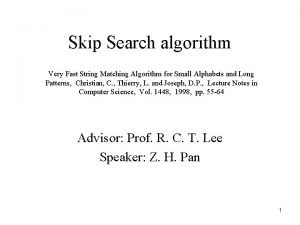
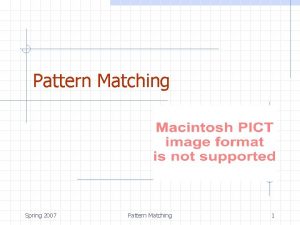
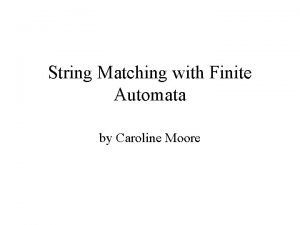
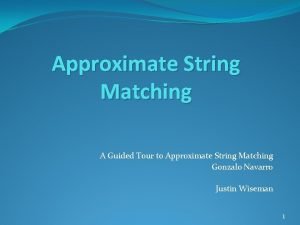

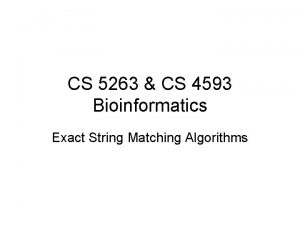

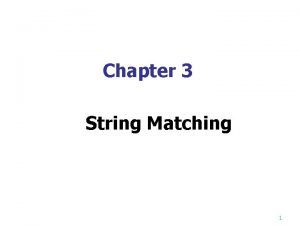
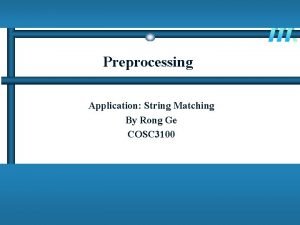
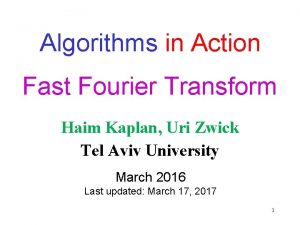
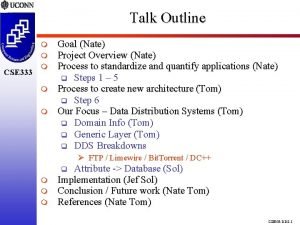
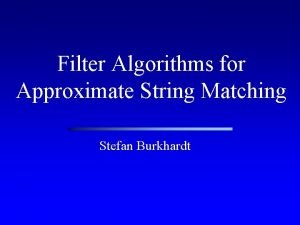


![String[::-1] String[::-1]](https://slidetodoc.com/wp-content/uploads/2020/10/1024931_080e9c6dd2cf7b5d559e4968699e87e9-300x225.jpg)










